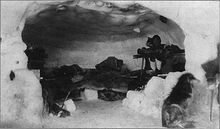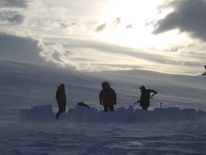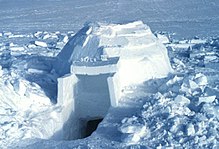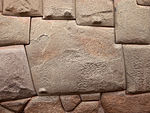Igloo

An igloo (Inuit languages: iglu,[1] Inuktitut syllabics ᐃᒡᓗ [iɣˈlu] (plural: igluit ᐃᒡᓗᐃᑦ [iɣluˈit])), also known as a snow house or snow hut, is a type of shelter built of suitable snow.
Although igloos are often associated with all Inuit, they were traditionally used only by the people of Canada's Central Arctic and the Qaanaaq area of Greenland. Other Inuit tended to use snow to insulate their houses, which were constructed from whalebone and hides.
Snow is used because the air pockets trapped in it make it an insulator. On the outside, temperatures may be as low as −45 °C (−49 °F), but on the inside, the temperature may range from −7 to 16 °C (19 to 61 °F) when warmed by body heat alone.[2]
Nomenclature

In the Inuit languages, the word iglu (plural igluit) can be used for a house or home built of any material.[1] The word is not restricted exclusively to snowhouses (called specifically igluvijaq, plural igluvijait), but includes traditional tents, sod houses, homes constructed of driftwood and modern buildings.[3][4] Outside Inuit culture, however, igloo refers exclusively to shelters constructed from blocks of compacted snow, generally in the form of a dome.[5]
Several Inuit language dialects throughout the Canadian Arctic (Sallirmiutun (Siglitun), Inuinnaqtun, Natsilingmiutut, Kivalliq, North Baffin) use iglu for all buildings, including snowhouses, and it is the term used by the government of Nunavut.[1][6][7] An exception to this is the dialect used in the Igloolik region of Nunavut. Iglu is used for other buildings, while igluvijaq,[8] (plural igluvijait, Inuktitut syllabics: ᐃᒡᓗᕕᔭᖅ) is specifically used for a snowhouse.
Types

There are three traditional types of igloos. Each has a different size from small to large and is used for a different purpose.[9][10]
The smallest-sized igloos are constructed as temporary shelters. They are usually used for one or two nights, and therefore, are easier to build. On rare occasions, these small types of igloos are used during hunting trips which are often on open sea ice.[9][10][11]
Intermediate-sized igloos were for semi-permanent, family dwelling. This was usually a single room dwelling that housed one or two families. Often there were several of these in a small area, which formed an Inuit village.[9][10]
The largest-sized igloos were normally built in groups of two. One of the buildings was a temporary structure built for special occasions, while the other one was built nearby for living. These large igloos could have up to five rooms and house 20 people. A large igloo could be constructed from several smaller igloos attached by their tunnels, giving common access to the outside. These large igloos were used to hold community feasts and traditional dances.[9][10]
Construction
Snow igloos are not spherical, but are built in a catenary, a curved shape more closely resembling a paraboloid. Using this shape, the stresses of snow as it ages and compresses are less likely to cause it to buckle because in an inverted paraboloid or catenoid the pressures are nearer to being exclusively compressive.[12]
The individual snow bricks are cut out of the ground with saws and machete-like blades. They are originally cut out in a four-sided shape. However, later the snow bricks are often cut into five- or six-sided shapes to increase structural interlocking,[13] similar to the stones used in the architecture of the Inca Empire.
Igloos gradually become shorter with time due to the compressive creep of the snow.[12]
Building methods
The snow used to build an igloo must have enough structural strength to be cut and stacked appropriately. The best snow to use for this purpose is snow which has been blown by wind, which can serve to compact and interlock the ice crystals. Snow that has settled gently to the ground in still weather is not useful. The hole left in the snow, where the blocks are cut, is usually used as the lower half of the shelter.[14]
Snow's insulating properties enable the inside of the igloo to remain relatively warm. In some cases, a single block of clear freshwater ice is inserted to allow light into the igloo. Igloos used as winter shelters had beds made of loose snow, skins, and caribou furs.[14] Sometimes, a short tunnel is constructed at the entrance, to reduce wind and heat loss when the door is opened. Animal skins or a snow block can be used as a door.
The igloo is architecturally unique in that it is a dome that can be raised out of independent blocks leaning on each other and polished to fit without an additional supporting structure during construction. An igloo that is built correctly will support the weight of a person standing on the roof.
Traditionally, an igloo might be deliberately consolidated immediately after construction[15] by making a large flame with a qulliq (kudlik, stone lamp), briefly making the interior very hot, which causes the walls to melt slightly and settle.[14] Body heat is also adequate, although slower. This melting and refreezing builds up a layer of ice that contributes to the strength of the igloo.[16]
- Igloo construction
- An igloo side view diagram; opening to the right, the optional window may be composed of a sheet of freshwater ice
- An igloo's snowbrick laying method
The sleeping platform is a raised area. With warmer air rising and cooler air settling, the entrance area acts as a cold trap whereas the sleeping area will hold whatever heat is generated by a stove, lamp, body heat, or other device. The Central Inuit, especially those around the Davis Strait, lined the living area with skin, which could increase the temperature within from around 2 °C (36 °F) to 10–20 °C (50–68 °F).
- Igloos
- Process of building an igloo with snowbrick method in mid-way
- A nearly complete, medium-sized igloo, with excavation under the door and the exterior unfinished
- Interior of an igloo, facing the passageway leading to the entrance
See also
- Glacier cave – a natural hollow space within a glacier
- Quinzhee – a shelter made by hollowing out a pile of settled snow
- Snow cave – a shelter constructed in snow
- Snow fort – a usually open-topped temporary structure made of snow walls that is usually used for recreational purposes
- Vernacular architecture – a category of architecture based on local needs, construction materials and reflecting local traditions
- Kamakura (snow dome)
References
- ^ a b c "Iglu". Asuilaak Living Dictionary. Archived from the original on 2019-08-27. Retrieved 2011-07-19.
- ^ "How Warm is an Igloo?, BEE453 Spring 2003 (PDF)" (PDF). Archived (PDF) from the original on 2012-04-17. Retrieved 2012-07-10.
- ^ "The Mackenzie Inuit Winter House" (PDF). Archived (PDF) from the original on 2012-04-01. Retrieved 2012-07-10.
- ^ "Reconstructing traditional Inuit house forms using three-dimensional interactive computer modelling" (PDF). Archived (PDF) from the original on 2009-03-26. Retrieved 2012-07-10.
- ^ "Definition: Igloo". Cambridge dictionary.
- ^ "About the Flag and Coat of Arms". Gov.nu.ca. 1999-04-01. Archived from the original on 2013-03-07. Retrieved 2012-07-10.
- ^ Inuinnaqtun English Dictionary. Cambridge Bay, Nunavut: Nunavut Arctic College, 1996.
- ^ "Igluvijaq". Asuilaak Living Dictionary. Retrieved 2011-06-29.[permanent dead link]
- ^ a b c d Gadacz, René R. (April 24, 2020). "Igloo". The Canadian Encyclopedia. Retrieved January 22, 2024.
- ^ a b c d Wielgopolan, Anna. "Igloo". Polarpedia. Retrieved January 22, 2024.
- ^ Smith, Craig S. (June 21, 2017). "A Lost Art in the Arctic: Igloo Making".
- ^ a b Handy, Richard L. (Dec 1973). "The Igloo and the Natural Bridge as Ultimate Structures" (PDF). Arctic. 26 (4). Arctic Institute of North America: 276–277. doi:10.14430/arctic2926. Archived (PDF) from the original on 2016-03-04.
- ^ kitikmeotheritage (2012-07-25), Building An Igloo, archived from the original on 2021-12-11, retrieved 2019-07-05
- ^ a b c Roald Amundsen (1908). "Chapter 8". The North West Passage, being the record of a voyage of exploration of the ship "Gyöa" 1903-1907. Vol. 2. London, Constable. p. 1-14. (a Norwegian observer's account of the building a family's winter igloo, not a short-term hunting one, by Atikleura and Nalungia, Netsilik Inuit)
- ^ Amundsen, Roald (1908). "3". The North West Passage, being the record of a voyage of exploration of the ship "Gyöa" 1903-1907;. Vol. 1. London, Constable. p. 145.
We were inexperienced at that time, and did not know that the hut ought to be heated inside in order to consolidate it.
- ^ "What house-builders can learn from igloos, 2008, Dan Cruickshank, BBC". BBC News. 2008-04-02. Archived from the original on 2009-03-11. Retrieved 2012-07-10.
Further reading
- Richard Guy Condon, Julia Ogina and the Holman Elders, The Northern Copper Inuit (ISBN 0-8020-0849-6)
- Igloo – the Traditional Arctic Snow Dome
- An article on igloos from The Canadian Encyclopedia
- Watch How to Build an Igloo (National Film Board of Canada)
- Field Manual for the U.S. Antarctic Program, Chapter 11: "Snow Shelters", pp. 140-145
- Traditional Dwellings: Igloos (1) (Interview; Library and Archives Canada)
- Roald Amundsen (1908). "Chapter 8". The North West Passage, being the record of a voyage of exploration of the ship "Gyöa" 1903-1907. Vol. 2. London, Constable. p. 1-14. (a Norwegian observer's account of the building a family's winter igloo, not a short-term hunting one, by Atikleura and Nalungia, Netsilik Inuit)
External links
- How to Build an Igloo (wikiHow)







